“We are all migrants through time.”
― Mohsin Hamid, Exit West
Olympia (UNESCO site)
Lesson Learned: Don’t ask for ground meat in Greece. You won’t find packages of hamburger in the grocery stores here. Ellen asked the butcher and even though most Greeks speak English (at least in the larger towns) he looked at her like she had lost her mind (he thought she’d been Trump-stricated). We picked up a package we thought was hamburger and it turned out to be more like Spam, and not good Spam at that. We asked an English-speaking waiter in Olympia and he got a chuckle when Ellen showed him the Google Translate version of a request for hamburger. Turns out that ground meat literally translated means you want beef that has fallen on the floor (dirt). For hamburger ask for “minced meat”. They probably won’t have it, so you pick out the cut of beef you want and they’ll grind it for you on request. Who knew?
Regrets: I actually had a taste of that Spam.
Monday, Feb. 11. We took the long ride out to Olympia, (about 3 hours) to see the archeological site. I don’t know who would ever could come down to the Peloponnese without going to see the most famous location on the peninsula. It did not disappoint us.
We rolled in to town at about noon. The archaeological ruins holds over 70 significant buildings, and the remnants of many of these structures survive (to some degree), although the main Temple of Zeus exists only as stones on the ground. The site is a major tourist attraction (but not in February), and has two museums (one focused on the excavation efforts which closed before we got around to looking at) and the other on artifacts, which Ellen and I thought were more significant than either of the museums at the Acropolis or Delphi.
The weather was cool, but not bad for February (13 Celsius) considering it was about 30 (F) degrees back home in Alexandria. We wore light shells that cut the wind and the light sprinkles that came down throughout the day.
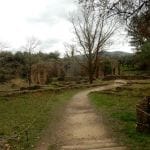
The site consists of an odd arrangement of buildings, the most important of which are the Temple of Hera, the Temple of Zeus, the Pelopion (alleged tomb of Pelops, the king of Piza and Godfather of Pappa Johns), and the great altar of Zeus, where the largest sacrifices were made. The Olympic stadium was huge and I’m sure was the Jerry World of the day. The original Olympic Games were founded in the 8th century B.C. Around the stadium extensive ruins include athletic training areas, the palace of Nero (yup, the “Rome is burning” Emperor), Roman bath houses (they must have been a very clean bunch of people), and various houses for artists, politicians, priests, and even slave quarters. It also housed the Archaeological Museum of Olympia with exhibit finds from the site, including a statue of Hermes attributed to the sculptor Praxiteles that is the star attraction of the museum.
We found the museum the most fascinating thing in the ruins and spent at least two hours there though it really wasn’t that large of a structure. The statues there far outshone any others we’ve found in Greece. I could have stayed there all day just looking at the collection of pottery dug up from the site.
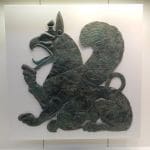
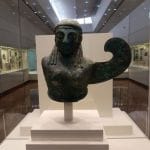
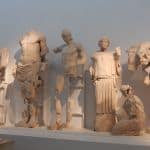
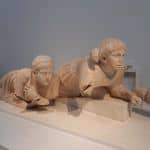
According to Wikipedia the first Olympic festival was organized on the site in 776 BC. Major changes were made to the site around 700 BC, including levelling land and digging new wells. The earliest evidence of building activity on the site dates from around 600 BC(a mere 2,600 years ago). At this time the Skiloudians, allies of the Pistans, built the Temple of Hera. Personally, I’d never heard of these tribes before, they were all Greeks to me (I’ve heard of Sparta, Athens, Thebes, etc.).
The Treasuries and the Pelopion were built during the course of the 6th century BC. It turns out that these temples and entertainment facilities were the main financial districts in Grecian antiquity. As we saw at the Acropolis and at Delphi each city state constructed elaborate treasuries which apparently were the Chase, Citibank, Bank of America, and JP Morgan of the day. There was no ATMs in sight, though. The first stadium was constructed around 560 BC. Its lasted a lot longer than Texas Stadium or the Ballpark in Arlington (Globe Life Field) have.























































